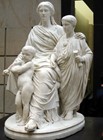Cornelia was the first of many female representatives of epistolary production whose texts are not preserved. They are only known because they are referenced by their recipients. The letters had a private purpose and their authors are related to the protagonists of Roman history from the 1st century BC and to the imperial court: Servilia (mother of Brutus), Pilia and Caecilia Attica (wife and daughter of Atticus), Terentia and Tullia (wife and daughter of Cicero), Publilia (second wife of Cicero), and Fulvia (wife of Mark Antony). Related to the emperor are his mother Acia, his sister Octavia the Younger, his daughter Julia the Elder, and his wife Livia.

Cornelia
(mother of the Gracchi)
Rome, 189 BCE — Misenum, 110 BCE
Period of activity: 174 BCE — 110 BCE
Geographical classification: Europe > Italy
Socio-cultural movements
Antiquity > Roman culture > Republic
Groups by dedication
Educators
Writers > Epistolographers
Writers > in > Latin
Context of feminine creation
Review
Born in 189 BC, she was the daughter of Scipio Africanus and Aemilia Paulla Tertia, who participated in the riot to abolish the Oppian Law. The Scipios directed cultural life and attached importance to the education of their women. She was married to Sempronius Gracchus and she became a very young widow. Out of twelve children, only Sempronia and the Gracchi reached adulthood. She was a cultured, intelligent woman, defender of the political cause of her children and an example of univira (woman who only married once). There are two pieces of her writings, still preserved today, that are considered the first in the epistolographic genre.
Activities
-
Amicae meae carae, salve!
[en]
[es]
[cat]
-
Cornelia: Letters from a Matron
[en]
[es]
[cat]
-
Fragment 1 of Cornelia: degrees of adjectives (1)
[en]
[es]
[cat]
-
Fragment 1 of Cornelia: gender and number (2)
[en]
[es]
[cat]
-
Fragment 1 of Cornelia: the noun phrase (3)
[en]
[es]
[cat]
-
Fragment 1 of Cornelia: the present stem (4)
[en]
[es]
[cat]
-
Fragment 2 of Cornelia
[en]
[es]
[cat]
Justifications
Biography
Cornelia was the daughter of the famous general Publius Cornelius Scipio Africanus and Aemilia Paulla Tertia.
Shortly after her father's death, Cornelia married the consul Tiberius Sempronius Gracchus. Out of her 12 children, only Sempronia, Tiberius and Gaius reached adulthood. In 155 BC, when her husband died, she decided to dedicate herself solely to educating her children. Cornelia was in charge of providing them with a good education based on respect for family traditions, but also adapted to the new trends that incorporated the formation of Greek culture.
Cornelia rejected several marriage proposals from important men of the empire. She even turned down an offer from the Egyptian king Ptolemy VIII.
A cultured and intelligent woman, she instilled in her children a love for their neighbor, introducing them to the Hellenistic humanistic ideas that defended support for the popular classes. In comparison with the ostentation that other patrician ladies made of luxury and their jewels, Cornelia proudly showed her children: "Here are my jewels."
Cornelia was known as the "mother of the Gracchi" especially during the riots that caused the reforms that her children wanted to carry out in the Roman Senate.
During her children's years of fighting, Cornelia championed her cause like a lioness and worked to win supporters.
With most of her family members gone, Cornelia decided to retire to live in a villa far from Rome where she devoted herself to the study of Greek, Latin and philosophy. Once she became the symbol of the Roman matron, exemplary wife and mother, the mother of the Gracchi received educated men and women who admired her courage with exquisite hospitality.
Cornelia had the honor of seeing a statue of her erected in the Roman Forum. It was the first time that privilege had been given to a woman. In the epigraph of the base it can be read: Cornelia, daughter of Africanus and mother of the Gracchi. Two fragments of letters have survived which are the first evidence of Roman prose written by a woman and which inaugurate the epistolary genre.
Ferrer, Sandra. (20 mayo 2011). Matrona romana, Cornelia Africana (189-110 a. C.). Blog: Mujeres en la historia. ( retrieved on 14.05.2021), <https://www.mujeresenlahistoria.com/2011/05/matrona-romana-cornelia-africana-189.html>
Bibliography
-Casamayor, Sara (2016). “Mujer y memoria en la Roma Republicana: Cornelia, Matrona ejemplar”, en Manuel Cabrera y Juan Antonio López, VIII Congreso virtual sobre historia de las mujeres, pp. 141-163, (retrieved on 14/05/2021), <https://www.revistacodice.es/publi_virtuales/viii_congreso_mujeres/comunicaciones/9_sara_casamayor_def.pdf>
-Dixon, Suzanne. (2006). Corneli: Mother of the Gracchi. Londres: Roudlege.
-Ferrer, Sandra. (20 mayo 2011). "Matrona romana, Cornelia Africana (189-110 a. C.)". Blog: Mujeres en la historia, ( retrieved on 14.05.2021), <https://www.mujeresenlahistoria.com/2011/05/matrona-romana-cornelia-africana-189.html>
-López, Aurora. (1994). No solo hilaron lana. Escritoras romanas en prosa y verso. Madrid: Ediciones Clásicas, pp.31-48.
-López, Aurora. (1988). Modelando con palabras. La elaboración de las imágenes ejemplares de Catón y Cornelia, Madrid: Ediciones clásicas.
-Montero, Mercedes (2004). “Cornelia, hija y madre de héroes”, en Jesús de la Villa (ed.), Mujeres de la Antigüedad. Madrid: Alianza Editorial, pp.123-140.
Didactic approach
-CUC: Block Classical roots of today's world. Everyday life; Block Continuity of cultural heritage. Literature, art and science.
-Latin 4th ESO: Block The Latin text and translation; Block Legacy and heritage; Block The present of Latin civilisation.
-Latin Baccalaureate: Block The text: comprehension and translation; Block Literary education.
-Universal Literature 1st Baccalaureate: Interpretation of fragments from the Roman period of different genres and themes.
-Spanish Language and Literature ESO: Literary Education Block.
- Catalan Language and Literature.